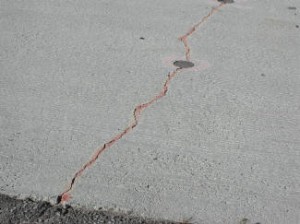Cement Tests
Compressive Strength

PCC is most often known by its compressive strength. This is because PCC is much stronger in compression than it is in tension and thus, is often used in compression. The ACI Concrete Code gives some rough rules-of-thumb for converting compressive strength to tensile and flexural strength:
read more ...Early Age Behavior

The service life of PCC pavements is highly dependent upon their early-age behavior. Rigid pavements are significantly affected by temperature and moisture changes during the first 72 hours following placement. Stresses in the PCC build up primarily due to the combined effects of curling and warping and restraint to axial movements at the slab-subbase interface. These stresses may be of sufficient magnitude to cause cracking because PCC strength is relatively low during this early-age period (see Figure 89 and Figure 90). Pavement stresses during this time are extremely important to long term pavement performance.
read more ...Portland Cement Compressive Strength

The most common strength test, compressive strength, is carried out on a 50 mm (2-inch) cement mortar test specimen. The test specimen is subjected to a compressive load (usually from a hydraulic machine) until failure. This loading sequence must take no less than 20 seconds and no more than 80 seconds. Table 12 shows ASTM C 150 compressive strength specifications.
read more ...Portland Cement Fineness

Fineness, or particle size of portland cement affects hydration rate and thus the rate of strength gain. The smaller the particle size, the greater the surface area-to-volume ratio, and thus, the more area available for water-cement interaction per unit volume. The effects of greater fineness on strength are generally seen during the first seven days (PCA, 1988[1]).
read more ...Portland Cement Flexural Strength

Flexural strength (sometimes called the modulus of rupture) is actually a measure of tensile strength in bending. PCC flexural strength testing is carried out on a 40 x 40 x 160 mm (1.57-inch x 1.57-inch x 6.30-inch) cement mortar beam. The beam is then loaded at its center point until failure.
read more ...Portland Cement Loss on Ignition

Loss on ignition is calculated by heating up a cement sample to 900 – 1000°C (1650 – 1830°F) until a constant weight is obtained. The weight loss of the sample due to heating is then determined. A high loss on ignition can indicate prehydration and carbonation, which may be caused by improper and prolonged storage or adulteration during transport or transfer (PCA, 1988[1]).
read more ...Portland Cement Setting Time

Cement paste setting time is affected by a number of items including: cement fineness, water-cement ratio, chemical content (especially gypsum content) and admixtures. Setting tests are used to characterize how a particular cement paste sets. For construction purposes, the initial set must not be too soon and the final set must not be too late. Additionally, setting times can give some indication of whether or not a cement is undergoing normal hydration (PCA, 1988[1]). Normally, two setting times are defined (Mindess and Young, 1981[2]):
read more ...Portland Cement Soundness

When referring to portland cement, “soundness” refers to the ability of a hardened cement paste to retain its volume after setting without delayed destructive expansion (PCA, 1988[1]). This destructive expansion is caused by excessive amounts of free lime (CaO) or magnesia (MgO). Most portland cement specifications limit magnesia content and expansion. The typical expansion test places a small sample of cement paste into an autoclave (a high pressure steam vessel). The autoclave is slowly brought to 2.03 MPa (295 psi) then kept at that pressure for 3 hours. The change in specimen length due to its time in the autoclave is measured and reported as a percentage. ASTM C 150, Standard Specification for Portland Cement specifies a maximum autoclave expansion of 0.80 percent for all portland cement types.
read more ...Portland Cement Specific Gravity

Specific gravity is normally used in mixture proportioning calculations. The specific gravity of portland cement is generally around 3.15 while the specific gravity of portland-blast-furnace-slag and portland-pozzolan cements may have specific gravities near 2.90 (PCA, 1988[1]).
read more ...Portland Cement Tensile Strength

Although PCC is not nearly as strong in tension as it is in compression, PCC tensile strength is important in pavement applications. Tensile strength is typically used as a PCC performance measure for pavements because it best simulates tensile stresses at the bottom of the PCC surface course as it is subjected to loading. These stresses are typically the controlling structural design stresses.
read more ...